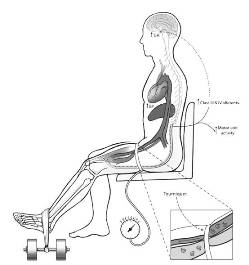A central part of the research activities in MoB deals with aspects related to skeletal muscle physiology, with specific reference to exercise, physical activity, and inactivity as well as health, aging and disease. This includes a strong focus on basic regulatory mechanisms, which links the muscle cell’s energy production with its energy consumption in order to address basic cellular fatigue mechanisms and to examine their influence on whole-body function.
The research is taking place in cooperation with several partners nationally and internationally.
We use different techniques at both the whole-body level (humans and rats) and the isolated single cell level, while also studying cell organels, gene transcription and intracellular signaling molecules.
|
By using isolated myofibre preparations we are able to closely control the intra-cellular environment and to activate the muscle fibre into contraction. Data from these studies show that both the content and subcellular localisation of glycogen as well as mitochondria function strongly affects the molecular signaling systems directly, and thus are elements that are crucial for a normal muscle function. Furthermore, we have shown that the muscle’s ion-balance and capacity for Ca2+ release are strongly influenced by the cell’s energy status (positive and negative modulators). Through our research data we have been able to illustrate how the muscle fibre’s excitability and Ca2+ regulation is controlled by the cell’s energy status, which constitute an essential element in the cellular regulation of human skeletal muscle function. |
 |
Adaptations in skeletal muscle mass and function are primary outcomes of changes in activity with aging and disease as well as in sports and with musculoskeletal injury. A substantial part of the research activities in MoB examines how muscle masss homeostasis is regulated at the cellular molecular level. How can scientific studies in healthy as well as highly trained athletes help to enhance recovery processess in humans with skeletal muscle loss and disease? In MoB we have an increasing focus on myogenic stem cell (SC) function and proliferation, both with respect to quiescent intramuscular SC's as well as circulating endothelial precursor cells, while also examining the influence of molecular signaling from fibroblasts, pericytes and extracellular matrix. Recently we were the first to discover that quiescent myogenic SC's are activated to an extreme extent when low-load resistance exercise is combined with partial blood flow restriction, resulting in an unusually high rate of myofibrillar hypertrophy. Experiments currently are conducted to target the key signaling events involved in this hyperactivation of myogenic SC's. Potential candidates include nitric oxide (NO), myostatin, Wnt and reactive oxygen species dependent signaling. Currently we use immunohistochemistry, western blotting, alphaLISA and alphaSCREEN to identify myogenic SC's and the activity in related anabolic signaling pathways in isolated muscle fibers obtained from human biopsies. One among several strategies will be to establish primary stem cell cultures and single fiber cultures and to use a combination of cell labeling and time-lapse imaging to pinpoint the cellular events that regulate the initiation of SC proliferation and eventually myotube formation.
You may also take a look at Biomechanical and neuromuscular research areas
See examples of on-going research projects at MoB